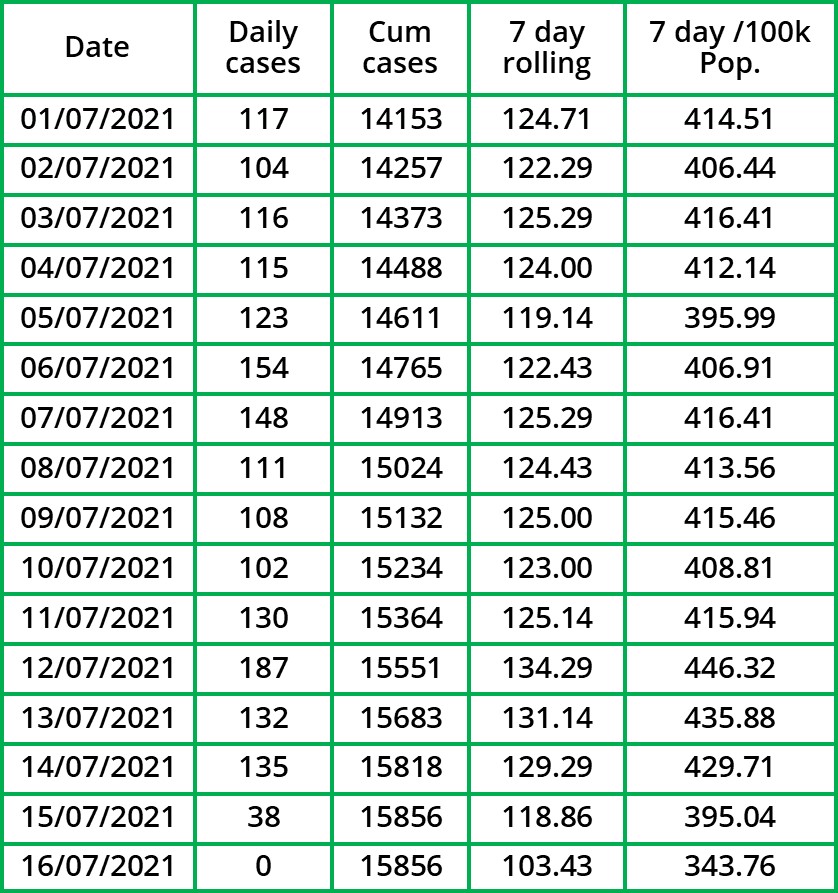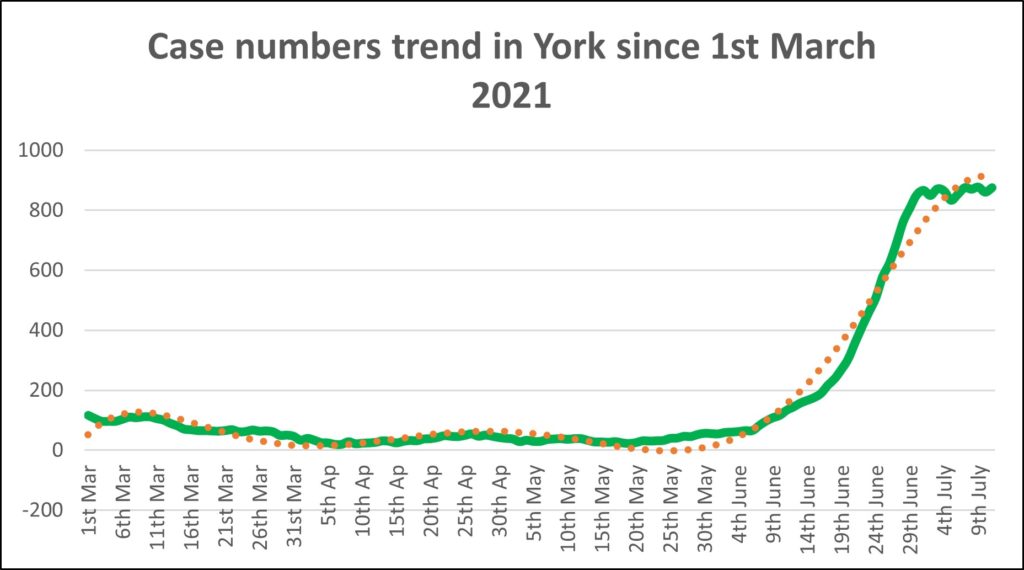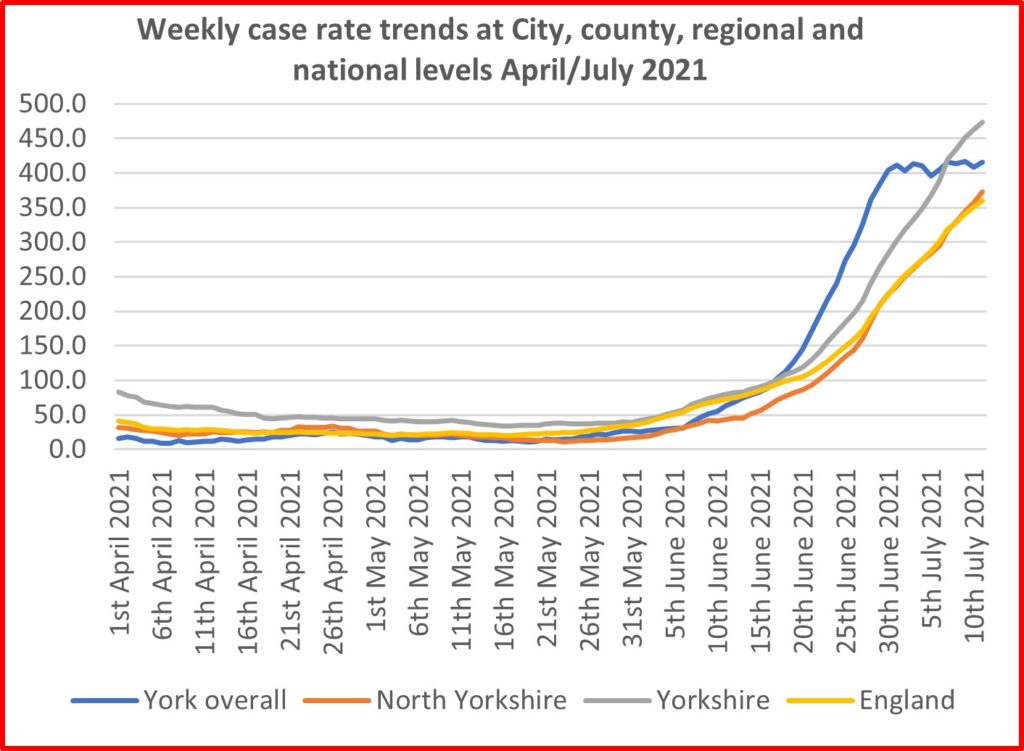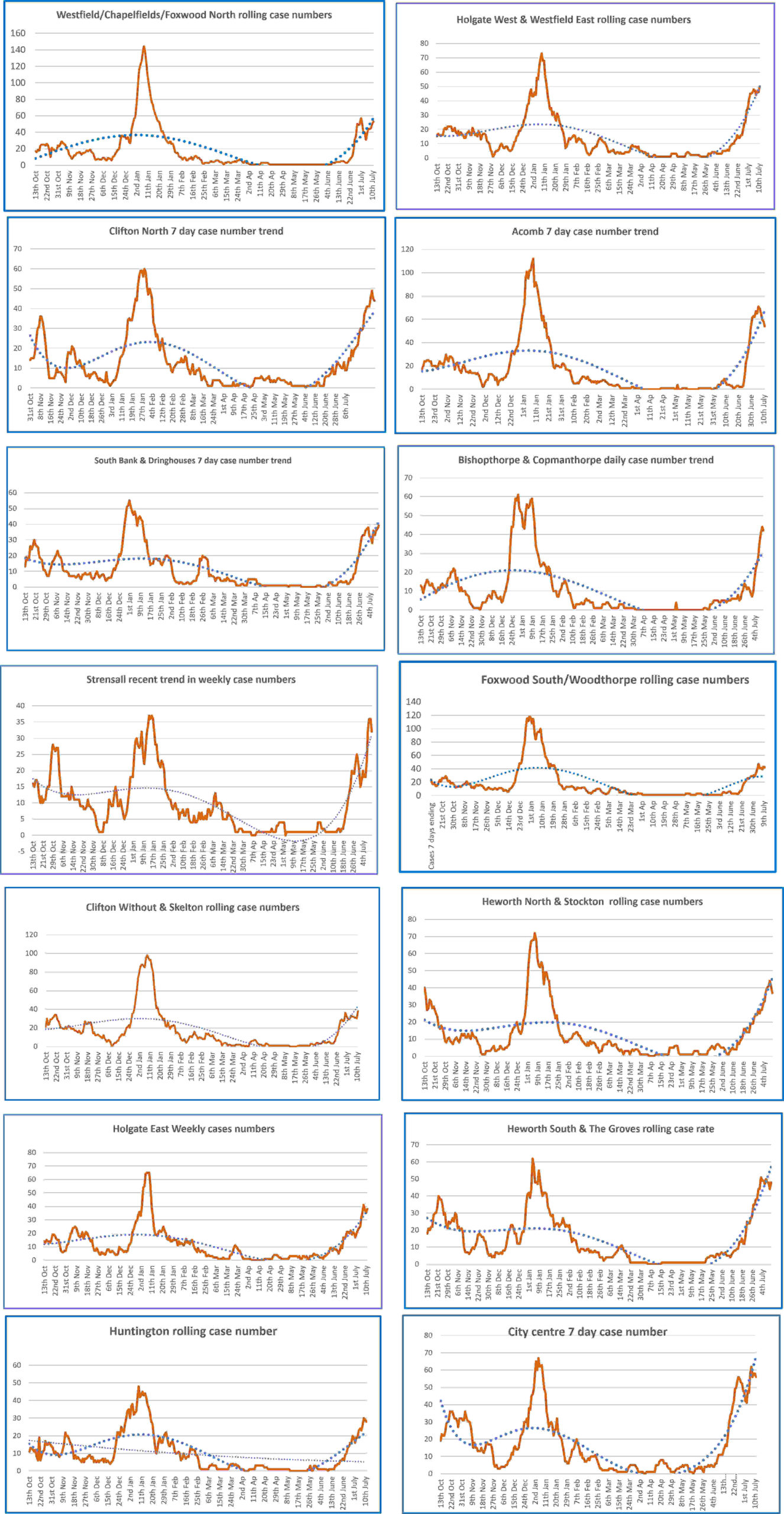Hospitals & Deaths
Two additional COVID-19 deaths have been announced by the York Hospital Trust today. Both occurred on Wednesday. They are the first fatalities notified since the 30th June.
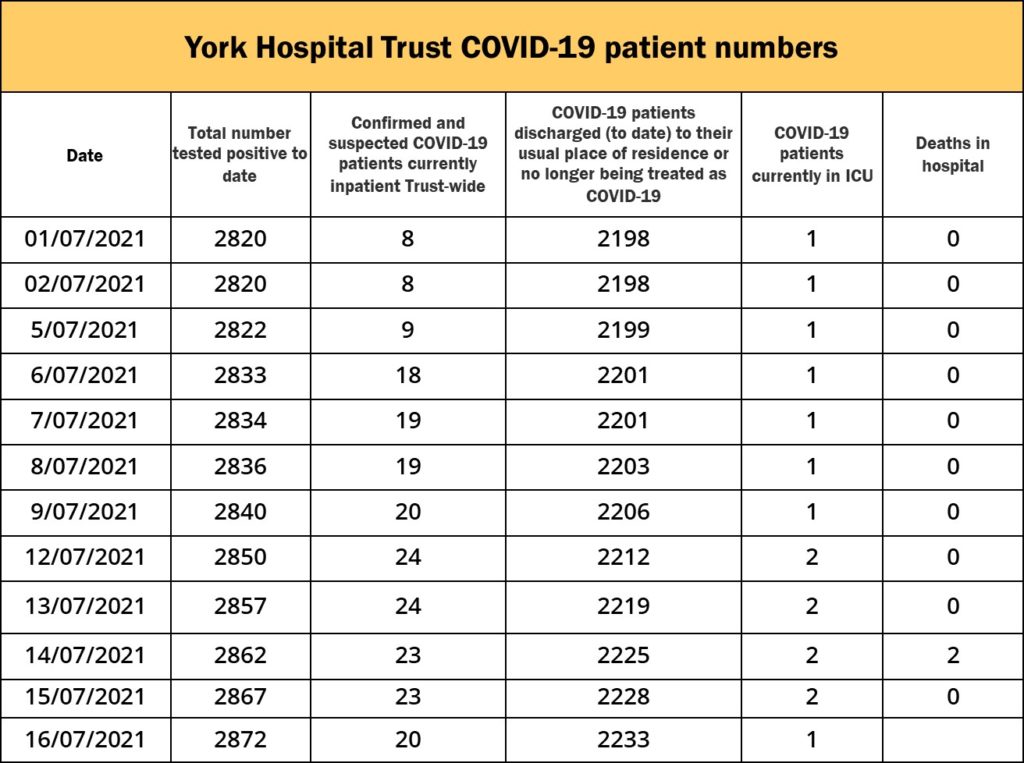
Test results
135 positive test results today. Brings the cumulative total up to 15,856
The number of cases in the City has increased from 861 to 876
The rate /100k population is now 415.94. A further increase is expected when tomorrows figures are confirmed.
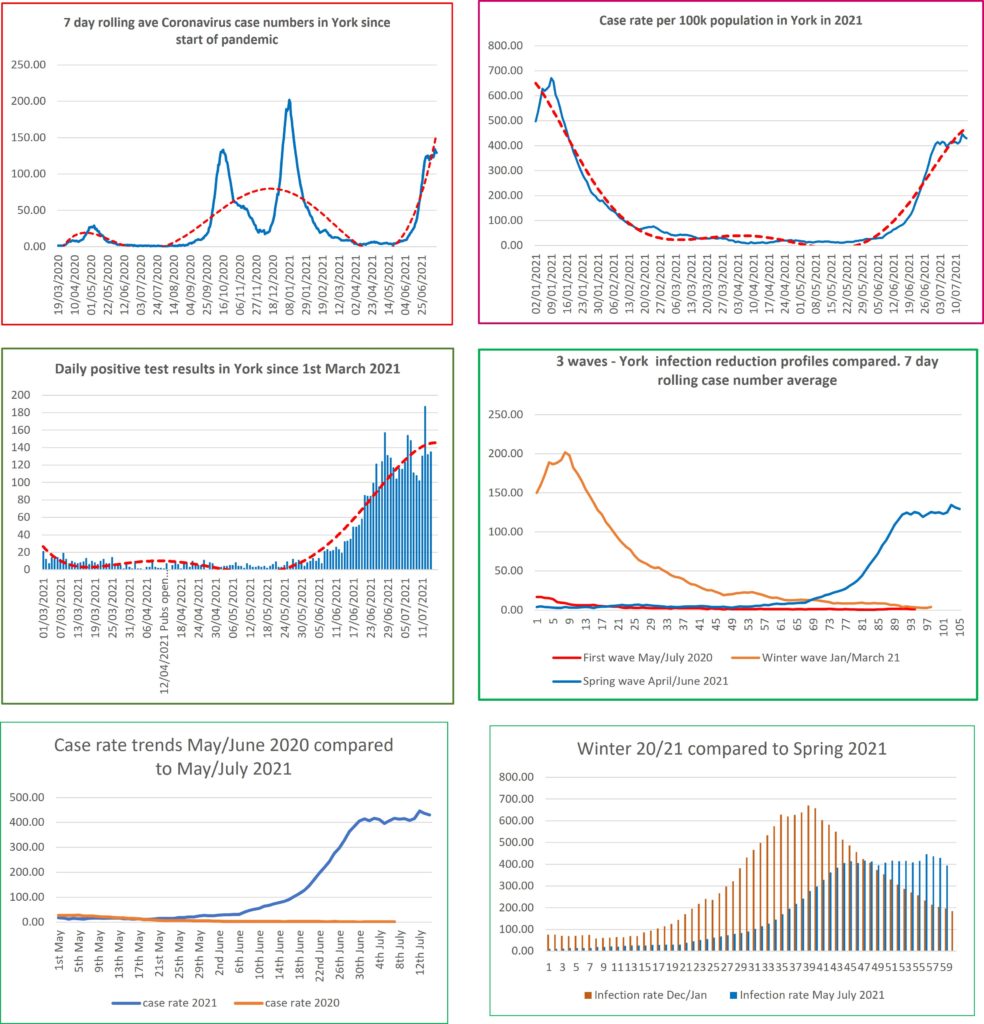
Neighbourhoods
The highest infection rate is currently in the Foxwood North/Westfield/Chapelfields neighbourhood.
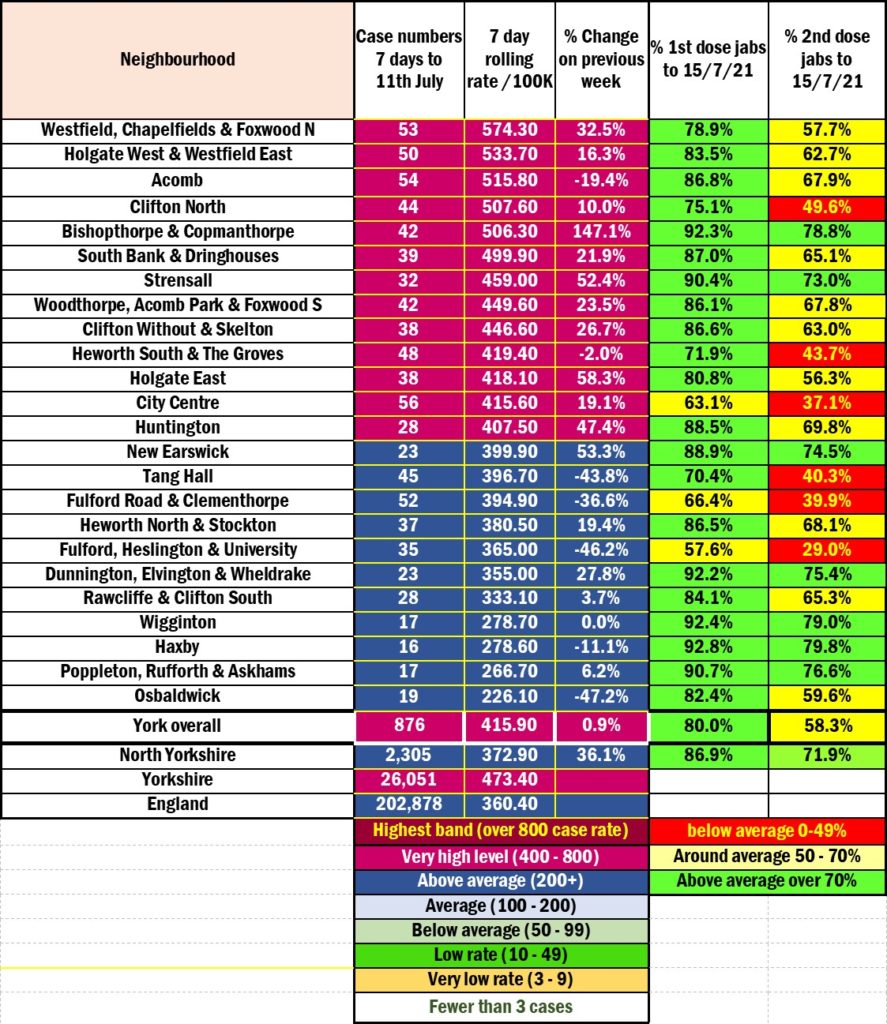
Vaccinations
661 vaccinations were completed yesterday (Thursday)
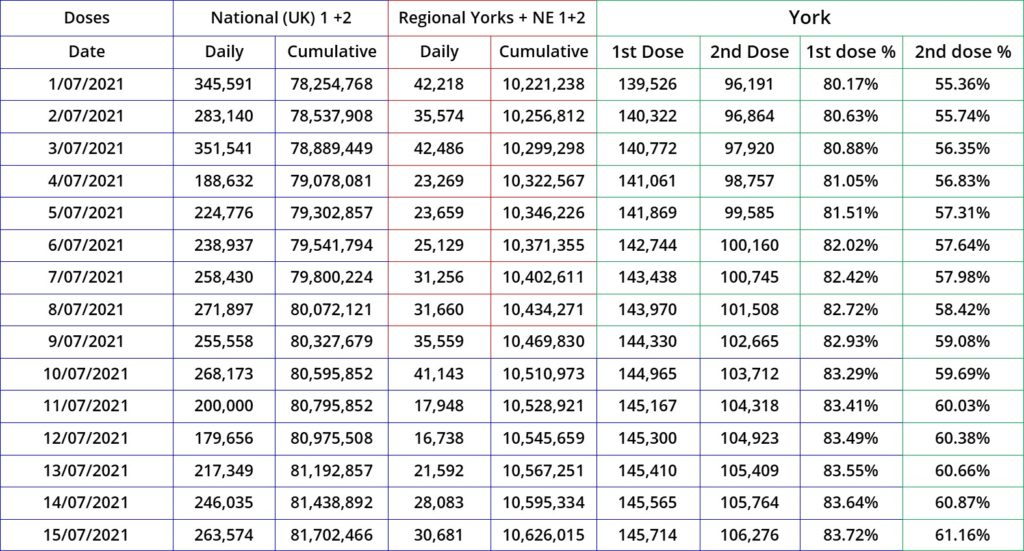
Tests
- 8305 PCR tests were undertaken during the week ending 11th July 2021
- Of these, 11.0% were positive. This is higher than the 10.6% positivity found during the previous period
- In addition, 3464 “lateral flow” tests were undertaken on 14th July.
Council commentary
The York Council has updated its “open data” commentary on the pandemic
The data is accurate as at 8.00 a.m. on Friday 16.07.21. Some narrative for the data covering the latest period is provided here below:
People with Covid Symptoms
• NHS Pathways/111 triages – as at 13.7.21 there had been 51 total covid telephony triages in the CYC area in the last 7 days. The peak number of triages was 192 in the 7 day period to 22.9.20.
• As at 15.7.21, the Covid Symptom App estimates 671 per 100,000 in York with symptomatic covid (responses from a sample of 3,756 people). The peak rate was 1,283 on 7.1.21.
Diagnosed cases
• As at 15.7.21 York has had 15,721 cases since the start of the pandemic, a rate of 7,464 per 100,000 of population. The cumulative rate in York is below the national (8,162) and regional (8,809) averages.
• The PHE ‘Exceedance’ rating compares the no. of new cases over a 14 day period with the previous 6 weeks and provides a RAG rating to indicate if the previously observed trend in the number of new cases is worsening. The latest rating for York (12.7.21) is Green.
• The provisional rate of new Covid cases per 100,000 of population for the period 7.7.21 to 13.7.21 in York is 430.6 (907 cases). (Using data published on Gov.uk on 15.7.21).
• The latest official “validated” rate of new Covid cases per 100,000 of population for the period 4.7.21 to 10.7.21 in York was 408.8 (861 cases). The national and regional averages at this date were 350.3 and 463.4 respectively (using data published on Gov.uk on 15.7.21).
• York is currently ranked 104th out of 149 Upper Tier Local Authorities (UTLAs) in England with a rank of 1 indicating the lowest 7 day rate.
• For the 7 day period 4.7.21.to 10.7.21, the number of cases in each ward varied from 14 to 72 and rates varied from 240.4 to 627.1 per 100,000.
• The rate of new Covid cases per 100,000 of population for the period 4.7.21 to 10.7.21 for people aged 60+ in York was 72.6 (36 cases). The national and regional averages were 70.6 and 95.8 respectively. Case rates are highest in the following age ranges: 15-19 (1,100 per 100,000); 20-24 (743); 10-14 (695) and 30-34 (626).
• As at 13.7.21, the latest 7 day positivity rate in York (Pillar 2 PCR tests only) was 16.01%. The national and regional averages are 13.5% and 17.5% respectively.
• As at 13.7.21 the latest 7 day positivity rate in York (Pillar 2 Lateral Flow Tests only) was 1.38%. The national and regional averages are 1.3% and 1.8% respectively.
• As at 13.7.21 the latest 7 day positivity rate in York (Pillar 1 tests only) was 1.4%. The national average is 1.6%.
• As at 9.7.21 York University reported 110 individuals within the University community who were currently self-isolating because they have had a positive COVID-19 test. The peak number was 331 on the 19.10.20.
• As at 12.6.21 York St. John reported 2 individuals within the University community who were currently self-isolating because they have had a positive COVID-19 test. The peak number was 82 on the 8.10.20.
Contact Tracing
• Local Contact Tracing. Between 10.3.21 and 9.7.21, 1,599 referrals had been actioned by the local contact tracing service. Of the referrals actioned, 1,481 (92.6%) were successful and 118 (7.4%) were unable to be reached via phone or home visit, but guidance leaflets were posted where possible. (NB on the 10.3.21 the local CYC team became responsible for contacting all cases rather than just those that the national team could not contact).
Cases in Residential Care Settings
• As at 15.7.21 there were 7 care homes in the CYC area with confirmed Covid-19 infection (at least 1 case of either a staff member or resident).
• The latest ‘outbreak’ (2+ cases of either a staff member or resident) in a residential care setting in York were reported by PHE on 2.7.21 (1 home).
Cases amongst School Aged Children
• In the 7 days up to 12.7.21 there were 158 children of primary or secondary school age who tested positive (across 39 different schools).
COVID Bed Occupancy in York Hospital
• As at 13.7.21 there were 15 confirmed Covid-19 patients in General/Acute beds. The previous figure was 15 on 7.7.21. The peak number was 157 on 19.1.21.
• As at 13.7.21 there were 2 confirmed Covid-19 patients and 0 suspected Covid-19 patients in the Intensive Treatment Unit. The previous figures were 1 and 0 on 7.7.21. The peak number for people in ITU was 19 on 10.5.20.
R Number
• The ‘R’ value (the number of people that one infected person will pass on a virus to, on average) for the North East and Yorkshire area on 9.7.21 was estimated to be in the range 1.3 to 1.6. The previous estimate was (1.2 to 1.4) on 2.7.21.
Variants of Concern
• In the latest month for which data is available, 792 cases in York (with a specimen date between 11th June 2021 and 10th July 2021) had been processed in a laboratory which is able to carry out the required sequencing in order to identify Variants of Concern (VOC) or Variants under Investigation (VUI). Of these, there had been 786 cases (genomically confirmed or provisional genotyping) of the Delta Variant of Concern (VOC-21APR-02) which was first identified in India.
Total Vaccinations
• As at 14.7.21 a total of 146,162 CYC residents have had the first dose of the vaccine. This represents 83.8% of the estimated adult (18+) population of York (ONS 2020)
• As at 13.7.21 a total of 105,945 CYC residents have had both doses of the vaccine. This represents 60.7% of the estimated adult (18+) population of York (ONS 2020).
• Source: PHE Covid-19 Situational Awareness Explorer.
Deaths
The two sources about deaths from Covid-19 at LA level are ONS data and local registrar data. They are derived from the same source (civil registration data). ONS data is more comprehensive as it includes deaths of York residents which have occurred and been registered outside York. Local registrar data provides a breakdown by age and gender. For both data sources a death from Covid-19 is said to have occurred when Covid-19 has been recorded on the death certificate. The most recently available data is summarised below:
• ONS Weekly data: In the most recent period (Week 26: 26.6.21 to 2.7.21) 0 Covid-19 deaths were recorded as having occurred for CYC residents. There has been one recorded covid death between week 18 and week 26.
• ONS Cumulative data: Since the start of the pandemic, for deaths occurring up to 2nd July 2021 and registered up to 10th July 2021, 397 Covid-19 deaths were recorded as having occurred for CYC residents (228 in hospital, 136 in care homes, 25 at home/elsewhere and 8 in a hospice). The number of deaths per 100,000 of population in York is 188.49 which is lower than the national average of 233.30
• Age / Gender breakdown (using registrar data): The average age of the CYC residents who died was 82.1, with an age range of 40-104. The age profile of the CYC residents who have died is older than the national average (79.4% were aged 75+ compared with 72.9% nationally). 47.9% of the CYC residents who died were male. The national average is 54.4%.
Freedom (to infect) Day?
This web site isn’t particularly impressed by the governments decision to end all legal restricitons on activities on Monday. We have the highest growth in infection levels in the world with growing numbers (nationally) being admitted to hospital. Death rates are also rising. The latest figures show that around 40% of those being admitted to hospital had been vaccinated.
The solution – to ensure maximum safety for the whole community – will have to be a local one. Much more is needed than the welcome – but inadequate – plea from political leaders that people be “kind” to each other.
- There must be a determined, high profile, effort to get more people vaccinated. That probably means taking the vaccinators to the patients rather than the other way round. Councillors have a major community role to play in such a process.
- A list of “drop in ” vaccination sites with opening hours should be maintained on a central web site and updated in real time. Any shortages (type of vaccine, staff) should be candidly reported
- The Council should support the use of “vaccine passports”. Although not favoured by some on civil liberties grounds, the sheer scale of the present problem requires compromises.
- Use of facemasks in public indoor areas should continue at least until case numbers reduce considerably.
- Access to busy indoor venues should be restricted (by the owners) to those who are double dosed and can produce proof of a recent negative test. Those venues imposing such conditions should be publicised. We beleive that there are many potential customers who would be encouraged to patronise a venue if it continued to be “COVID secure”.
- The local impact on the economy of workers self isolating following being “pinged” by the NHS App. should be reported regularly.
- More information should be provided each day on where and when infection contacts have occurred.
- The local authority must be pro-active and open in its plans for the new educational term. We cannot afford another spike in case numbers like the one that occurred last autumn.

